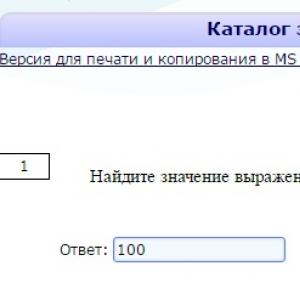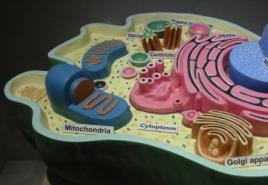Punctuation marks in a compound sentence are performed. Lesson summary "separating punctuation marks in compound sentences"
1. COMMA in a compound sentence
IN compound sentence its parts are connected by unions and yes (\u003d and or but), but, but, however, but, and then, not that, or, or, also, too and others. Before them or between repeated unions ( no no; whether ... whether; then ... then; not that ... not that and etc.) put comma . The wise path of the grain is beautiful, and the eternal light of the sun is beautiful. Below the river were meadows, and a forest rose up the hill. The door creaks, then the gate will open quietly.
No comma before the union andif it connects:
- two interrogative sentences. Who are they and what do they want?
- two incentive sentences. Holy name of the hero and his memory will be preserved for centuries!
- two exclamation points. How beautiful these places are and how good it is to rest here!
- two nominative sentences. Alien rocks and wet snow flying towards the car.
No comma before the unions and yes (\u003d and), or, orif simple sentences have:
- general introductory word. Apparently, he was in great difficulty and there was a struggle going on in his dog's soul.
- common minor member. Wings by the goose were spread out and the beak is open. BUT: Goose and wings are spread out, and the beak is open. (repeated conjunctions)
- general subordinate clause. For many centuries this land was dried by dry winds and the sun was burning until she got so strong.
- a general clarified sentence, linked by a non-union connection to the rest of the complex sentence. There were two events of equal importance: people learned to fly and people have forgotten how to be surprised at this.
2. DOT WITH COMMA in a compound sentence
The semicolon is put before the unions but, nevertheless, nevertheless, nevertheless (less often before and yes \u003d and), if at least one part of a complex sentence is significantly widespread or has commas in its composition.
Tatiana, on the advice of the nanny
Gathering at night to enchant,
Quietly ordered in the bath
Lay the table for two devices;
But Tatiana suddenly got scared ...
3. DASH in a compound sentence
Dash is put (more often before the union and, less often before a, but), if it is necessary to show a rapid change of events, a consequence or opposition. A little bit of happiness - and a person immediately becomes better, kinder. As if you had to rejoice - but there was no joy.
Punctuation is a rather difficult section of the Russian language. It includes a huge number of rules for the use of punctuation marks in writing. Some of these rules relate to complex sentences. In what cases are commas put, are other punctuation marks used in a complex sentence - questions that should be dealt with by both schoolchildren and those people who are improving their knowledge of the Russian language.
What are compound sentences?
In the Russian language there is such a concept as complex sentences. There are several types of them. One of them is complex sentences. This term is understood as a unit of language, which in its composition contains several simple sentences connected by intonation and compositional conjunctions.
In such designs, the parts are equal. Conjunctions that combine simple sentences are not included in any of the parts. To understand the essence of the term "compound sentence", examples are given below:
- The wind blew outside, and yellow leaves swirled and fell from the trees.
- Mom went to work, and Vasya decided to go to his classmate for a textbook.
- A thunderstorm will begin soon, but Mukhtar will not hide in his booth.
Classification of complex sentences
Constructions formed on the basis of a compositional connection are classified into sentences with an open and closed structure. The first of them may contain more than two parts. There are only two components in proposals for closed-structure structures.
For complex sentences with an open structure, the meaning of simultaneity is characteristic. They can be extended with additional parts. Used in constructions optional connecting ( yes, and, no ... no) and separating ( either, or, then ... then) unions.
For proposals with a closed structure, the above-mentioned feature is not typical. They can be compared to a closed series. Parts of the sentence are structurally and semantically related, interdependent. The conjunctions that are used are - and, but, however, but, but.
Examples of compound sentences with an open structure
These constructions in Russian are divided into several types:
- Connecting sentences. They express the relationship of temporal succession, the relationship of simultaneity. Punctuation marks in a compound sentence are shown by an example: The door opened and guests entered the room.
- Separating sentences. They express a relationship of alternation, mutual exclusion. A fire was lit somewhere, or there was a fire. This construct is a mutually exclusive proposal. Either Liza spun at her desk, then Vasya threw notes in the direction of the next row. And here is the alternation proposal.

Examples of compound sentences with a closed structure
In order to accurately place punctuation marks in a complex sentence, to do the exercises perfectly, you need to know that closed-structure constructions are classified as follows:
- Sentences with addition values. Rain started pouring down, and small drops of it began to fall softly to the ground.
- Sentences expressing effective value. The second part expresses the result, effect or conclusion caused by the first part. As the day drew to a close, the objects in the room were gradually losing their contours.
- Offensive sentences. Everyone knew him, and no one wanted to communicate with him.
- Comparative sentences. The father left the room, and the mother was left alone with her daughter.
- Comparative-spreading constructions. In the distance an old, ruined house could be seen, and next to it lay the logs brought by the owners of the land.
- Inconsistency suggestions. The sun rose outside, and Vasya was still asleep.
- Adversely restrictive sentences. In such constructions, one of the parts reports on the situation, which limits the manifestation of the action in the other part. Andrei wanted to stop the search, but Alexandra did not want to give up.
- Adversarial and concessional proposals. The rain had stopped long ago, but the ground was still damp.
- Disgusting and repulsive offers. The decor in the house was simple, not rich, but the atmosphere seemed very cozy and warm.
Putting commas in a compound sentence
In each of the above examples, you'll notice a comma. The use of punctuation marks in a complex sentence is explained by the existing rule. It says that simple parts that are part of a complex structure are separated by commas from each other.
If we supplement the above rule, then we can say that commas separate parts of a compound sentence, connected by unions:
- connecting;
- dividing;
- disgusting;
- connecting;
- explanatory.

Cases when before the unions and, yes, or, or the comma is not put
Many schoolchildren who do not yet know all the rules for using punctuation marks think that before unions and, yes, or, or always put commas in a compound sentence. In fact, this is not the case. There are several exceptions to this general rule. So, no comma is put:
- when simple structures that are part of a compound sentence have a common secondary term ( Residents walked along the village street and children rode bicycles);
- when simple constructions from a compound sentence have a common subordinate clause ( When the show ended, the curtain fell and the audience applauded.);
- when simple constructions explain the common third part associated with them by a non-union connection ( She felt bad: her temperature rose and her head felt pain).
Commas before separating and connecting unions are also not put if the structures include interrogative, exclamatory or incentive sentences. Example: When does the meeting start and what questions will the attendees discuss?
Dash in a compound sentence
What punctuation marks are used in a compound sentence? The design can contain not only commas, but also dashes. This punctuation mark is used in cases when there is a sharp opposition or unexpected addition in the second part of the sentence. The dash serves as a substitute for a comma. The stranger threw the manuscript into the fire - and suddenly thunder rumbled.
The punctuation mark is also placed in those constructions in which their parts are one-part nominative (or nominative) sentences. Here are some examples of dashes in compound sentences:
- A sudden clap of thunder - and a blinding lightning flashes in the sky.
- Another two or three hours and the performance will end.
- One shot - and the hunter struck a bird rising into the sky.

Punctuation marks in compound sentences: the rule of using semicolons
This punctuation mark is used in several cases. Firstly, it is necessary when parts of a compound sentence are widely spread. The semicolon divides the design into two parts, which greatly facilitates the perception of information. He constantly gave her flowers, courted beautifully, spoke affectionate and gentle words that could turn the head of any woman; but she did not pay attention to him, did not see all his merits and positive qualities.
It should be noted that the semicolon is used mainly in those sentences in which parts are separated by unions yes and, but, however, but... In rare cases, the punctuation mark is used in the construction before the union and.
Some additional nuances in using semicolons
Before the unions and, yes (with meaning and) semicolons are not always used. This punctuation mark is used only when two parts are combined in a compound sentence, which, without the named unions, could be separated by a dot. In the morning there was delicious soup, spring rolls and meat patties on the table; and while they ate, my mother came into the kitchen to ask what to cook for us for lunch.
Sometimes semicolons are optional, that is, optional. Here's an example: He already knew Sveta, she was not brought from far away, from a neighboring village, and even before she was taken to him. Commas are used in a compound sentence. The parts that make up are connected by an alliance and yes... It forms a connection between two one-piece indefinitely personal sentences.

Colon in compound sentence
A colon is a punctuation mark that separates a sentence into two parts. One of them is connected with the other causal and explanatory relationships. Colon may be present in compound sentences. On the street the weather changed: the wind rose and clouds covered the sky.
As you can see from the example above, the part containing information about wind and clouds shows how the weather has changed. If there are no explanatory and generalizing parts in the constructions, then punctuation marks in a complex sentence in the form of colons are not used.

conclusions
Punctuation marks in a compound sentence can be different (comma, dash, semicolon). In some cases, a colon is required. It is worth remembering that it is very important to correctly distinguish complex constructions from simple sentences that are complicated by homogeneous predicates. Here are some examples:
- The students asked a question and the teacher answered it.
- The sun peeped through the window and illuminated the interior with rays.
The first sentence is complex. In it, the parts are separated by comma and union and... The second construction from the example also contains this union. However, the comma is not put in the sentence, since it is not complex.

In conclusion, it is worth noting that our speech consists of sentences, some of which are complex. It is very important to know the rules for setting commas, dashes, semicolons, and colons. The point is that in oral speech we use intonation to understand us better, and in writing we use punctuation marks. They are of great importance, they can even decide the fate of a person. The importance of the function of punctuation marks in a compound sentence, as in any other, is confirmed by the famous phrase "to execute cannot be pardoned." That is why it is necessary to memorize the rules, learn to apply them in practice.
Compound is a sentence that has independent parts connected with each other. As a rule, the components have equal semantic and grammatical meaning. There can be a comma, semicolon, or dash in between. Punctuation marks in compound sentences are one of the most difficult topics in punctuation.
Connecting unions
Which ones are put in It depends on the context. And in order to answer this difficult question, first of all it is necessary to understand what kind of construction such a unit of language has. If it consists of two or more simple sentences, then this is a compound sentence. Moreover, its parts have a semantic connection with each other, and they are separated by punctuation marks. In a complex sentence, in most cases, these are commas. They are put in the presence of one of the connecting unions (and, yes). Examples:
- The autumn foliage burned in the sun in shades of green, red and yellow, and in this bright multicolor the desolate and dull riverbank looked so strange.
- Take a look around and you can see so many new and interesting things.
- Elena spoke in a whisper, and her mother also tried not to make noise.
Adversary alliances
These service parts are necessary for the unification and connection of homogeneous members of the proposal. They create a semantic opposition between them, emphasize the difference or inconsistency. And these words are always preceded by punctuation marks. In a compound sentence - in the presence of opposing conjunctions - the constituent parts are separated by a comma. Examples:
- Ivan Petrovich's whole body ached from fatigue, but it was so pleasant to be in an interesting company and listen to his favorite music.
- We must finally take out all this old furniture in the trash, but other things do not leave any time for household chores.
- Colleagues treated the new history teacher with hostility, while the students loved her with all their hearts.
- Material dependence on anyone is not in its principles, but work and a separate apartment create a feeling of freedom.
- Parents will have to take action, or he will one day be expelled from school for such academic performance.
In addition to such service parts of speech as but, but, yes, but not that, adversaries also include unions but, however, otherwise.

Separation Unions
Punctuation marks in a compound sentence are placed before such service parts of speech as either, or, then ... then, or ... or, whether ... or, not that ... not that. In the presence of a double separating union, a comma is always placed before its second component. Examples:
- Calm down, or it will be bad.
- He then fell silent, then began to speak again.
- Something needs to be done or he will die!
- Whether he had serious intentions or whether he was playing again was not clear.
Dividing punctuation marks between parts of a compound sentence in the presence of a double conjunction are placed before its second component.
Connecting unions
These include unions, yes, and, moreover, also, too. One of them must be preceded by a comma. Examples:
- He liked her more and more, he, too, seemed to be not indifferent to her.
- The appearance of this man made a rather depressing impression, his voice was also unpleasant.
Explanatory conjunctions
As the name implies, these words are intended to clarify and clarify. Unions of this kind - namely, that is. They must always be preceded by a comma. Examples:
- After this terrible event, the number of tenants decreased, namely, only the gentleman with an impassive expression on his face and two old women who could hardly hear anything remained.
- The time was suitable for the conversation, that is, it was quiet, calm and there was no need to fear the arrival of intruders.

When are punctuation marks not used?
The compound sentences, examples of which are given below, do not have a comma. Each of them has a connecting union. But parts of the sentence are united by a secondary member, and therefore no punctuation mark is required. Examples:
- Soon after the train arrived, the town was flooded with tourists and idly wandered through its streets until late at night.
- His mother has huge, kindly hazel eyes and soft flaxen hair.
- By that time, the publishing house had published several children's books and two collections of poetry.
However, in the event that the members of the proposal are united by a minor member, but the union is repeated, a comma is put. Examples:
- On such a frosty winter night, the wolf does not wander, and the bear does not emerge from its den.
- In sunny calm weather you don't want to work, and the sandy beach beckons and distracts you from business.

as a general part
It is not only a minor member that can be common. A subordinate clause sometimes plays its role. And, of course, in this case, no comma is used either. Examples:
- It was already daylight and people were gathering at the bus stop when he was just returning home.
- When the guest was escorted home, it was completely dark outside and only moonlight illuminated the path.
- When he entered the stage, his heart was beating violently and his hands trembled noticeably.
Interrogative sentence
You should know that commas are not always put before the connecting union. In some cases, punctuation marks are not required in complex sentences. Examples:
- Who is he and why did he come without a preliminary call?
- How did they get here and what do they need?
- What time will the meeting take place and what exactly will be discussed there?
- Will Magomed come to the mountain or should you go to Magomed?
In each of the above examples, the sentence consists of two interrogative stems. The parts are united by interrogative intonation. Therefore, punctuation marks in a complex sentence of this type are not required.

Similar to the previous examples, punctuation marks between parts of a compound sentence are not required in the following phrases:
- Dismiss all employees and hire new ones only after my approval!
- How ridiculous he is and how absurd his antics are! (Exclamatory sentence.)
- They began to look for traces of the crime, but, as always, they did not find anything (vaguely personal proposal).
You should know that when repeating a conjunctive conjunction, a comma is put between the impersonal parts of the sentence. Example: Rain, wind, and haze.
Semicolon
Punctuation separators between parts of a compound sentence are not always commas. If parts of a complex structure are common sentences and have commas inside them, separate them with a semicolon. Examples:
- He invented all this himself, because he absolutely did not remember what he had dreamed last night; but when his mother, touched by this story, began to soothe and console him, he almost burst into tears.
- She became unbearably sad the moment they saw each other for the last time; however, something like relief appeared in her soul.
- He spoke to her affectionately, held her hand, and happiness shone in his eyes; and she took everything for granted, because she was used to enthusiastic looks and had long ceased to appreciate them.
A comma with a period is often placed before such unions as but, however, and, on the other hand... And only in rare cases - before a. Examples:
- These strange works on the construction of the building were carried out for five years; but either the climate was unsuitable, or the material was of poor quality, only the matter did not advance above the foundation.
- He studied well, although he was not particularly assiduous; he never seriously grieved about anything; however, from time to time some wild irrepressible stubbornness found him.
- Drunkenness and carelessness were common among the inhabitants of this village; but many necessary qualities were rare for the local inhabitants: hard work, honesty, friendliness.
The rules for setting punctuation marks in complex sentences may allow the presence of a semicolon in front of unions yes and and... But only in those rare cases when this sign stands between two sentences, which without it would be separated by a dot. Example:
- Soon the whole park, warmed by the rays of the spring sun, came to life, and dew drops, like diamonds, sparkled on the tulips; and the old, already somewhat neglected park seemed festively elegant that day.

Dash
All of the above sentences are examples of the rules that the student should know. high school... One of the topics that is given special attention in Russian lessons is "Punctuation marks in a compound sentence." Grade 9 is an important stage in school curriculumwhen the knowledge gained earlier is generalized and consolidated. The dash in complex sentences is a deeper topic. It is worth giving at least a few examples of the use of this punctuation mark.
It is put in cases where there is a sharp opposition or adherence in the second part of the proposal. Examples:
- The hunter threw something into the blazing fire - and immediately everything around lit up.
- He hurried there, ran as fast as he could - and there was not a soul.
To correctly place punctuation marks in a complex sentence, it is necessary to determine the composition of its parts. And if there are only two of them, and each of them is one-part nominative, a dash should be put between them. Examples:
- One more moment - and he will fall at her feet.
- Ten years of such existence - and the human soul is broken.
Splitting a sentence into two semantic parts
Sometimes in one long phrase there is a description of two phenomena or actions. In such cases, the sentence is divided into two semantic parts using a dash. Example:
- In the mountains, if you push a small stone from a great height, it will touch another in flight, then a third, and they will entail tens, and then hundreds - and now a terrible stone avalanche is rapidly collapsing downward.
But the dash can also separate simple constructions: “One has only to say a kind word - and the person is saved”.

Punctuation marks in complex and complex sentences are topics that can only be mastered with the help of practical exercises. Rules are memorized faster if you use different schemes. Although spelling and punctuation are parts of the humanities, it is worth creating simple graphic images. Especially when it comes to such a topic as "Punctuation marks in complex sentences."
Table (conjunctions and punctuation marks in compound sentences)
Below is a table that contains the basic rules for using commas, semicolons and dashes between parts. Also, conjunctions are indicated that correspond to a particular punctuation mark.
| Punctuation marks don't trumpet | Comma | Semicolon | Dash |
| Before the unions and yesif parts of the sentence have a common element (minor term of the sentence, subordinate clause, introductory word, particle) | and yes , too, also, moreover
| Parts of the proposal circulated | In the second part, there is an attachment or opposition |
| A sentence consists of parts, each of which is an interrogative, motivating, exclamatory or vaguely personal sentence | Between simple sentences, before unions but, however, not that, moreover | One or two parts are nominative sentences | |
| A sentence consists of parts that include synonymous words | Between simple sentences, before unions or, or | The sentence splits into semantic parts | |
| Between simple sentences, before unions namely, that is | The offer consists of short designs |
From the foregoing, it should be concluded: in order to correctly place punctuation marks, it is necessary to determine the type of sentence, highlight it grammatical basics, and then understand what type of unions are the service parts of speech that connect the parts of this sentence.
Page 1 of 2
Difficult cases of punctuation. Comma before the conjunction "I"
Union "and" can connect, first of all , homogeneous members of the sentence, secondly , simple sentences in complex.
To correctly put a comma before the conjunction "and", it is necessary to distinguish the structure of a compound sentence from simple sentence with homogeneous predicates or subjects. Therefore, we first recall the definitions of simple and complex sentences.
For instance: It was miraculous as if the whole forest was twisting at once and the earth was groaning. (union "and" single)
He recalled how the fascists attacked them suddenly , and how they ended up surrounded , and how the detachment still managed to get through to their own. (union "and" repeats)
Unfortunately, the division of rules into punctuation for homogeneous members of a sentence, signs in a complex sentence and working with difficult sentence, including homogeneous subordinate clauses, leads to the inability of many who finish the course of the Russian language to navigate how and when this or that rule is applied. In addition, theoretical knowledge often does not allow to correctly figure out which of the rules must be applied, therefore, even with knowledge of the rules, not all students are able to use them appropriately and appropriately.
Therefore, we offer you another way of assimilating this punctogram, which was indicated by N.V. Nikolenkova: go from "external" signs of the organization of the sentence, that is, from the number of used unions "and"... We believe this will make it a little easier to work on the correct placement of punctuation marks.
Go to the second page on this topic







